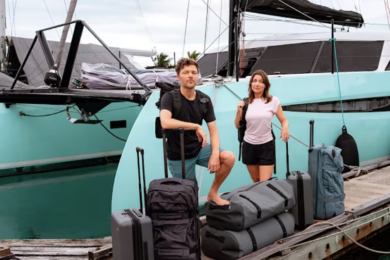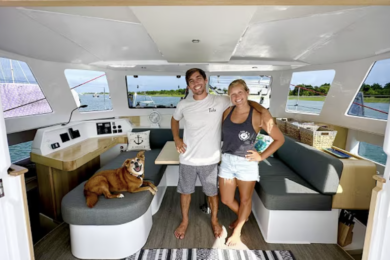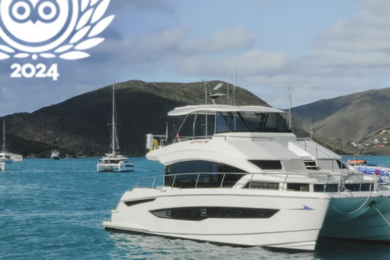A critical look at various steering positions on cruising catamarans, their advantages and disadvantages (Published Winter 2016)

The cruising catamaran has come a long way from its Polynesian origins. New building materials, advances in production techniques, findings in aero and hydrodynamics have shaped this once ancient sailing craft into the most popular cruising and liveaboard platform. What has remained a constant in the last 50 years however has been the basic layout and accommodation plan. The saloon and cockpit are on the main deck and staterooms and heads below. The galley is one of the few variables—as especially on cats above 40 feet it can be found either in the hulls or on the main deck.
Rather different are the steering stations which designers place in the stern, midships, on so called “mezzanine” helm stations, the flybridge or even in front of the coachroof. The vast majority of cruising cats utilize wheels although some builders offer additional tillers helmed via aft seats. Each of these steering positions has their advantages and drawbacks in terms of the activities of keeping watch, sail handling and weather protection. There are some iterations of these basic steering positions but we will focus on the most popular.
THE AFT STEERING POSITION
This is the classical helm position for most monohull sailboats and there is a reason for it. Not only does it provide the sailor with the best overview to each weather side (most aft steering cats have helms on each quarter) but also gives superior helm feedback of any type of wheel steering. The aft location of the wheel, very close to the rudder steering arms, allows the use of a mechanical system of rods, cables and chains versus the lesser desirable hydraulic steering system.
One of the big Achilles heels of cruising catamarans is their lack of fun factor under way as they are so stable. Although many travel at 10 knots or more, they dilute the sensation of speed and excitement. If you want to “feel” your catamaran under sail, an aft steering position coupled with a mechanical linkage is the only way to go. Nautitech (now owned by Bavaria Yachts) as well as Catana employ this type of steering which will cater to the performance oriented sailor.
Pros:
- Excellent sailing and helming sensation with easy view of telltales
- Excellent visibility to either side under sail (with twin wheels)
- Acceptable overview under power with no headsail when docking
- Excellent for solo docking or mooring as helmsman is close to the sides of the boat
- Excellent conviviality with guests in the cockpit and saloon
- Steering on same level as cockpit and easy to access
- Fair weather protection (with addition of sun bimini/dodger)
- Aft steering allows for the largest cockpit to saloon interface
- Great for learning as student can follow wheel motion of helmsman on opposite side

Cons:
- Difficult to enclose to protect against rain
- Bad overview under power (if only one set of engine controls) to opposite side when docking
- Somewhat expensive to build especially for twin helm stations
- Usually only room for maximum two people
THE MEZZANINE HELM
By far the most popular position to place a sailing catamaran’s helm is the mezzanine. This is the so called area halfway between the cockpit and coachroof level. Usually the seats are molded into the composite bimini top which makes production cheap and easy. Depending on the size of catamaran, these bench seats can seat between one and three people comfortably. In the 80’s and 90’s there was only one seat usually mounted on an unsightly pole which has now given way to more elaborate bench seating with cup holders and all controls in easy reach. Among the large manufacturers, Fountaine Pajot, Lagoon and Leopard use this type of mezzanine steering.
Pros:
- Good visibility to one side under sail
- Easy access from saloon
- Good overview under power with no headsail, especially docking
- Conviviality on larger bench seating
- Cheap to build
- Excellent weather protection (with addition of sun bimini/dodger)
Cons:
- Zero visibility to opposite side with headsail unfurled
- Bad overview under power to opposite rear quarter, especially when docking
- Bad helm feedback under sail (as most mezzanine steering stations have hydraulic steering)
- Somewhat strained vertical view to observe headsail trim
- Aesthetically challenging for designers
- Blocks one side of the cockpit preventing a completely open saloon/cockpit interface
THE FLYBRIDGE
While in the past only catamarans above 60 feet were equipped with a second story flybridge, manufacturers are equipping their smaller cats with a complete floorplan above the bimini and even full standing headroom on boats as small as 45 feet. The attraction is an added social area, separation from crew and a higher vantage point. This however comes at the expense of more windage, weight and reduced performance. Most flybridges have central integrated steering stations with a battery of winches flanking the helm on both sides. Especially on larger catamarans this layout works well as the crew is close to high load jammers and has the mast base in perfect view. Sunreef Yachts, as one of the most reputable builders of large catamarans above 60 feet exclusively places their steering station on the flybridge.
Pros:
- Excellent overview forward when docking under close quarters
- Easy monitoring of high load jammers
- Reduction of chafe because of shorter distances for some of the running rigging
- Somewhat easy to add bimini weather protection
Cons:
- Often no visibility to both sterns
- Zero visibility to opposite side with headsail unfurled
- Bad helm feedback under sail (as most flybridge steering stations have hydraulic steering)
- Somewhat strained vertical view to observe sail trim
- Aesthetically challenging for designers and smaller cats
- On flybridge helmsman is often isolated and too far from action which might need attention
- In rough seas the high location might make steering uncomfortable

Flybridge THE SPORT SEAT
Outremer Yachting has pioneered sport seat steering which is an option that customers can order on the Outremer 45, 4X, 51 and 5X models in addition to the standard bulkhead mounted helm. Judging from the fact that 90 percent of clients choose this feature is a witness to the popularity of this type of mechanical tiller steering. The advantages are obvious. Similar to the aft steering helms, the sport seat steering employs tillers which are directly linked via pushrods to both steering arms. A crosslink between the rudders stabilizes the system, and to improve the feel of the tiller even further the wheel helm system can be quickly uncoupled by a lever. The sport seat steering provides unrivalled fun at the helm and of all the helm stations in discussion, gives the best feedback and command to fine tune the heading of your catamaran. You sit in comfort of an armchair. The downside is that you have to get up to make any changes to sheets or sail controls. The seats are strictly reserved for steering. If you need weather protection you will seek it at the bulkhead steering or within the saloon.
Pros:
- Best helm feedback of any steering system (with tillers) and excellent view of the telltales
- Excellent visibility to either side under sail (with twin helms)
- Excellent conviviality with guests in the cockpit and saloon
- Great for instructional sailing as student can follow tiller motion of helmsman on opposite side
Cons:
- Difficult to enclose to protect against rain
- Usually only room for one helmsman per sport seat
- No engine or sail controls at sport seat. You need to use bulkhead steering to dock
- Some consider seats to look unusual on the deck of a sailboat
- Expensive to build. This is the reason builders only offer this as an option

Sportseat THE ARTICULATED HELM
This is an innovation that we have first seen on Loic Goepfert’s innovative Alibi catamaran which are built in Thailand. The wheel (sometimes two) is located just behind the saloon bulkhead and is mounted on an athwartships rotating arm. This allows for a multi-level steering experience which adds versatility by allowing sailors of different sizes optimum ergonomics as well as providing good visibility forward and protection behind the coachroof. In inclement weather you can steer in the down position (at cockpit level) and have a fairly good view to all corners of the boat—although you will have to view through the saloon windows to see forward. This would be problematic at night when there are lights turned on in the saloon. In good weather one rotates the wheel arm into the up position into basically a bulkhead mounted mezzanine steering location with good visibility forward over the saloon roof. The articulated helm is an interesting compromise yet adds complexity to already complicated structures. Most systems are mechanical and the cable runs back to the steering arms could be problematic. Also night view forward in the down position is difficult.
Pros:
- Good for sailors of all sizes
- Excellent weather protection without the addition of an ungainly bimini
- Versatility of multiple steering heights at cockpit and mezzanine level
- Good overview under power with no headsail, especially docking in mezzanine level
- Excellent visibility to either side under sail, with twin wheels
Cons:
- Bad night vision forward through saloon, at cockpit level
- Somewhat strained vertical view to observe headsail trim
- Blocks one side of the cockpit preventing a completely open saloon/cockpit interface
- Somewhat expensive to build especially for twin helm stations
- Complexity and possible reliability issues of long cable runs from midships to aft steering arms
THE FORWARD HELM
Chris White has pioneered the forward helm station in his popular Atlantic series of cruising catamarans. Later this steering location was adapted by the builders of Gunboat. This iteration locates the sailing helm between the forward part of the coach house and the mast. Most of the time this helm station is complimented by a fixed steering station in the forward part of the coachhouse which is used for docking or in inclement weather. Often all the winches and sail controls are in easy reach and the central location reduces the length of the running rigging easing the chafe issue on high load sail controls. The forward helm adds an interesting second social space and of all the systems discussed provides the best possible view forward—but also a compromised view aft, as one has to sight through the saloon. Some sailors might find the nearly vertical views to the telltales a strain on their neck. On catamarans up to 65 feet this forward cockpit could seem disproportionately cramped for the length of boat—yet the advantages are that you have all sail controls at arm’s length. The location of the forward cockpit, especially on faster catamarans will force sailors into the saloon especially when going upwind where spray can reach this central location. Especially on smaller cats the forward facing door leading to the forward helm could be vulnerable to breaking waves.
Pros:
- Forward visibility excellent
- Excellent access to sail controls and chafe reduction
- Second social area
- Low and centralized location provides comfortable motion
Cons:
- Difficult to protect in bad weather. You are forced to steer from inside saloon
- Critical watertight seal from forward part of coachroof to forward cockpit
- Bad visibility aft, you dock using the saloon located helm
- Usually the location forces builders to hydraulic systems providing you with no helm feel
- Some sailors might find a forward steering and a fixed saloon helm unorthodox
- On fast boats spray could reach forward cockpit especially sailing upwind
All systems are compromises and while proving advantageous in some aspects show drawbacks in others. We have critically addressed all systems in terms of sail and docking controls in day and night time conditions as well as in fair and inclement weather. Ergonomics and sight lines, weather protection as well as esthetics were considered. In looking at the various systems we had to contemplate the complexity (reliability and expense) of the systems as well as the resulting helming feel.
The truth is that on a passage 90 percent of the time cruising catamaran sailors utilize the autopilot. Once the heading is dialed in and the sails are set in harmony one engages the autopilot which takes care of the rest. Hand steering on long ocean journeys is usually reduced to highlights of wanting to steer the surfs while carrying a large headsail. This after all is sailing. If you are after this experience, opt for a mechanical steering from the aft sector of the boat which will give you the best view of the sails. If this is of lesser interest any type of helm station will provide you with advantages. Preferably try them all and you will make the best choice.Gregor Tarjan is owner/operator of Aeroyacht Ltd., a Long Island, NY based multihull dealership. He brokers Sunreef Yachts, Bavaria-Nautitech and Outremer catamarans.
















